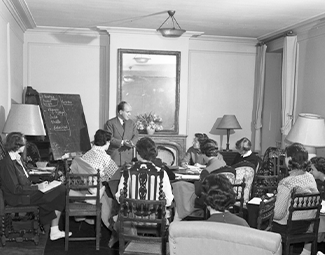The Study-Abroad Experience
My Junior Year in France […] has been the most important event of my life to date. Practically speaking, the fact that I was proficient in French helped me to obtain my first job, which was one for which I had aimed […] Although I did not use French a great deal in my work, it was on a number of occasions extremely valuable and contributed to my advancement and subsequent jobs. Since my marriage to a man in the diplomatic service, who now speaks French with some fluency, I have found many occasions where my French has proved useful; it has made contacts which have enriched our lives socially as well as benefited my husband professionally. Thanks to courses in art and literature which I had in France, I have continued to study in these fields with special interest. Even my taste in food bears evidence to a year of eating French cuisine. Nearly twenty years after the fact, I can see, even more clearly than at the time, how much twelve months in France affected my life (Pace 30).
The Emergence of Study-Abroad in the U.S.
In 1958, Robert C. Pace conducted an extensive survey of study-abroad programs, and more specifically the Sweet Briar program (Dr. Anne Pannell, president of Sweet Briar College, secured a grant from the Fund for the Advancement of Education of the Ford Foundation to finance the evaluation). According to the introduction by Donald J. Shank, Executive Vice President of the Institute of International Education and Chairman, undergraduates were sent to Junior year programs abroad with the following provisos:
- Careful selection of United States undergraduates, based on the full recommendation of the candidate by her home institution, which agrees that, subject to satisfactory completion of the program, the student will receive credit for the foreign experience.
- Educational and personal counseling of the student by selected faculty members during her study period overseas.
- Participation by the student in an intensive language and orientation program in the foreign country.
- Registration in certain regular courses at the foreign university, as well as in specially organized courses offered by foreign professors.
- Residence, wherever possible, with the family of a national of the country. Periodic reporting by the sponsor college to the home institution of the academic and personal progress of the student (Pace 3).
According to Pace, the overriding objectives of these programs were to foster “[…] a more active, international understanding and a continuing interest in international affairs. […] a world-mindedness in the sense of a greater friendliness to foreigners and a more genuine tolerance of diversity and other cultures, including a recognition of the contribution which other cultures have made to America and to the world” (10).
A 1958 Institute of International Education survey of college programs estimated that approximately 2,500 American students studied abroad for credit in 1956 – 1957: "Over 500 were participants in some type of ‘junior year abroad’ plan; over 400 were studying independently, and a small number held exchange scholarships. Just over 1,500 went in the summer, taking part in programs for which they received regular credit. (It is assumed that these are minimum figures, and that the actual totals, including students not reported in this survey, are larger)" (8).
By 1960, approximately 5,000 American students had journeyed to cities all over Europe through 85 distinct study-abroad programs, a significant jump from the previous year, which counted just 3,500 students in 64 programs. Those numbers were expected to exponentially increase in the following decades (Toy 1).
Study-Abroad in France
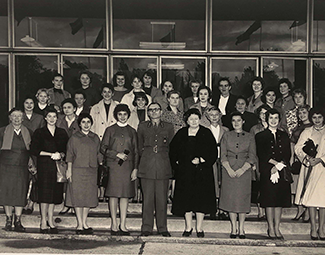
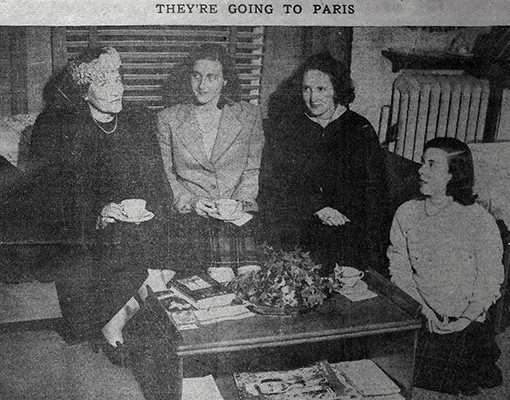
The 1950s were "the harbinger of a golden age of study abroad that began in the aftermath of the Second World War and continued for three decades, sending thousands of American students into French homes and French universities" (Kaplan).
In Paris, Reid Hall became the center of study-abroad programs and, as director, Dorothy Leet was particularly committed to the idea of promoting transatlantic ties between French and American institutions of higher education. She thus encouraged and developed programs that would bring American students in contact with French culture and society.
Beginning in 1947, Leet redoubled her efforts to promote Reid Hall as an ideal site for undergraduate and graduate study-abroad programs in literature, language, and art history. Students were enrolled in classes at Parisian universities, and their studies were bolstered by trips to other regions of France, and visits to châteaux, museums, and various cultural and educational sites.
Leet also strengthened Reid Hall's engagement with international institutions like NATO, UNESCO, and SHAPE (Supreme Headquarters Allied Powers in Europe), and she organized an annual October trip to their headquarters in the Paris region. A bus from SHAPE would retrieve the students from Reid Hall and take them to the NATO headquarters, where they would enjoy a “briefing” on the strategic situation in Europe. In a 1957 message to students, Leet wrote of this event: “Since the role of [these organizations] is of the utmost importance in the Western World today, this visit is of the greatest interest, and the briefing is of especial value in understanding the present-day situation in Europe and in the Western World” (Report to members, November 1, 1961).
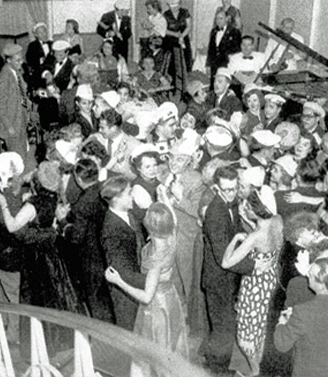
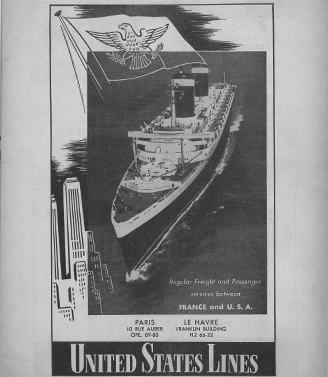
In the aftermath of WWII, passenger ships between the U.S. and Europe resumed their Atlantic crossings. Cohorts of American students sailed to France on a number of majestic ocean liners, the SS United States being especially popular (retired in 1969).
The students' departure from the United States was always a festive occasion, frequently feted by the French Consul in New York or other dignitaries, with luncheons, photo shoots, and newspaper coverage. In September 1957, for example, The New York Herald Tribune described "a tea for fifty...at the Hotel Westbury, Madison Ave. and 69th St., prior to their departure tomorrow on the liner United States for a year's study in Paris. They will be accompanied by their director, Miss Alice Ross Bennett." (September 18, 1957, pg. 17). In 1963, Charlotte Girard, director of the Third Year in Paris program, had this to say about the tea, also held at the Westbury:
[...] the tea at the Westbury was nice, but I think the arrangements of small tables has its drawbacks, people settle and don’t move. They do not meet others. The theory of less seats than people for the purpose of mixing might be invoked. I made a short announcement about seeing me on board, gave my cabin and reminded each girl that she should have some sort of receipt for any trunk shipped ahead (Report of Activities, C. Girard, 1963. Barnard Archives).
Aboard these vessels of discovery, significant efforts were made to prepare students for their experiences abroad. Emphasis was placed on cultural and linguistic immersion, which would ultimately lead to linguistic proficiency and increased confidence, and would thus transform them into informed citizens of the world. Cabin and dining room arrangements facilitated interaction between students, ensuring that those who came from the same junior college would be separated in order to meet other young people. Interviews with their program director and orientation sessions introduced them to their academic expectations, life in France, travel opportunities, housing rules and regulations, and readings. At these orientation sessions, vocabulary books, the Michelin guide, brochures, and other documents were distributed. Entertainment on the ships included dances and singalongs of popular French songs.
In her 1963 report on preparations for the crossing on the SS United States, Charlotte Girard, head of the Third-Year in Paris program, had this to say about the dining arrangements:
On the way over, I made a point of contacting the Dining Room Steward about the arrangements for meals and it was agreed that a sufficient number of tables would be reserved for us and that within these few tables we would be able to move. I assured him that the waiters would not lose in tips. When I check with him on the 13th, he had received something from “Head Office” which ordered him to put the girls three by three at tables with young men. He had it all worked out and it seemed impossible to change all his plans. It was agreed, however, that we could move within these tables. I gave all the girls all the numbers, but they were confused, sat five at a table where only three Reid Hall girls should have been, or at altogether the wrong tables, the waiters made a fuss, the assistant Steward likewise. The net result was that, after the second day, when the table numbers disappeared, no one moved to more than one table and the people who lived in the same cabin, stayed together for meals. I think we should really insist on our arrangements for the dining room as well as the cabins. If the U.S. Lines wants to play cupid and bring young men to the tables, they might at least put the girls at these mixed tables in the same area of the dining room. Needless to say it makes it very hard for the Directrice too, to meet all the girls, since she does not, either, have a mystic sense of direction in the dining room (Report of Activities, 1963. Barnard Archives).
She also commented on the general brouhaha upon leaving the vessel:
The girls were to meet me in the Smoking Room at a specific time so we could leave together, but some “forgot” and we lost much time in trying to find them. We did, in the end, by the train. The half-hour at Le Havre is really very difficult. The U.S. lines officials want to chat about the trip and find out how all went etc., the girls are excited to a pitch, can’t find their luggage, porters mill around in search of huge tips and it is impossible to have a really orderly handling of the luggage [...].
Sources
- Dougherty, David M. “The Value of a Year of Study in France for Undergraduates.” The French Review, vol. 23, no. 4, February, 1950, pp. 304-307. JSTOR
- Toy, Stewart. “Exporting Students: U.S. Colleges Expand Programs for Study in Foreign Countries.” Wall Street Journal, Dec 9, 1960, p. 1. ProQuest Historical Newspapers
- Rasmussen, Diane. “Here’s the Way – Study Abroad.” Iowa State University Digital Repository, vol. 37, no. 7, 1957, p. 6.
- “Reid Hall in Paris Offers Courses to Summer Students.” Barnard Bulletin, February 19, 1948, n.p. Retrieved from RH archives, scrapbook.
- “Reid Hall Tea for Fifty Today.” New York Herald Tribune, September 18, 1957, p. 17. ProQuest Historical Newspapers.
- Shank, Donald J. “Foreign Study for U.S. Undergraduates.” Institute for International Education, August, 1958, pp. 45. HathiTrust.
- Smith, Horatio. “The Junior Year Abroad.” World Affairs, vol. 96, no. 1, March, 1933, pp. 30-32. JSTOR.
- “Tea Today Honors Reid Hall Group.” New York Herald Tribune, September 18, 1958, n.p. Retrieved from Rh archives, scrapbook.
- “Tea Today Honors Reid Hall Students.” New York Herald Tribune, September 16, 1954, n.p. Retrieved from Rh archives, scrapbook.
- 23 students Going to Paris.” The New York Times. September 12, 1961, Education section, n.p. Retrieved from Rh archives, scrapbook.
- “U.S. College Girls Discover Richness of France.” New York Herald Tribune, January 25, 1948, n.p. Retrieved from RH archives, scrapbook.
- Walton, Whitney. “Internationalism and the Junior Year Abroad: American Students in France in the 1920sand 1930s.” Diplomatic History, vol. 29, no. 2, April 2005, pp. 255-278. JSTOR.
